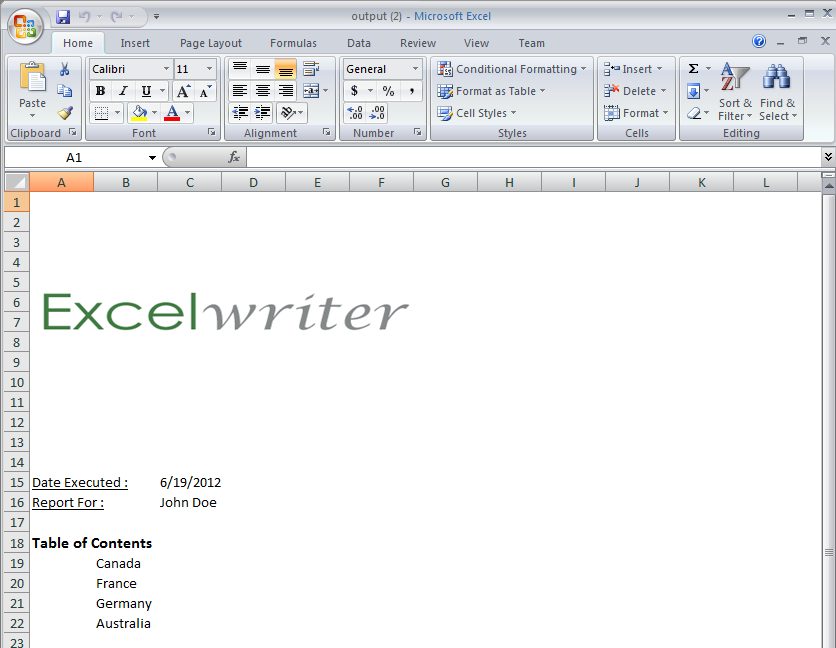Table of Contents |
|---|
Introduction
This part focuses on using ExcelApplication to create and a coversheet that an image, hyperlinks, and formatted text. It also includes binding data with ExcelTemplate.
Writing the Code
Writing the code for the cover sheet comes in two parts. the first part uses ExcelApplication to create a template coversheet; and the second part uses ExcelTemplate to bind the appropriate data to the data markers on the cover sheet.
Creating the coversheet with ExcelApplication
We want to create a cover sheet that looks like the following Excel worksheet:

Setup
1. Define a method to contain the ExcelApplication code to create a new worksheet and customize it. In the sample, there is an AddCoverSheet() method that holds the code for the ExcelApplicattion code in this part of the tutorial.
2. You should have already completed Part 1 of this tutorial. To include the AddCoverSheet() method, just add a call in GenerateTemplate()
Adding the cover sheet
1. In AddCoverSheet, create a new worksheet called "Summary" at the beginning of the workbook with Worksheets.CreateWorksheet:
2. Select the "Summary" worksheet as the worksheet that will be active when the workbook opens with Worksheet.Select().
3. Hide the gridlines in the summary worksheet using Worksheet.ShowGridlines. By default, this property is set to true.
Inserting an image
1. The image will be inserted in cell A1. Adjust the height of row 1 to accommodate the image by retrieving the RowProperties object of row 1:
Note: The row height is set in units of 1/72 of an inch.
2. In the example, the user can select an image to insert into the file. The path of that image is dynamically retrieved and stored in variable imagePath.
3. Create an Anchor in cell A1 with Worksheet.CreateAnchor(). Set the offsets to 0.
4. Then insert the Picture object using Pictures.CreatePicture.
Writing Text
1. Set the Cell.Value of cell A3 to the string "Date Executed :". In cell A4, set Cell.Value to "Report For:". In cell A6, set the Cell.Value to "Table of Contents".
2. Insert the data markers for the "Date Executed" and "Report For" data, which will be imported using ExcelTemplate.
3. Next we will add hyperlinks to each of the worksheets in the workbook. To do this, we will use Excel's native HYPERLINK formula to point to the other worksheets. The format for the HYPERLINK formula will be:
=HYPERLINK("#DestinationSheet!DestinationCell", "Display Text")
This will be set to the Cell.Formula property.
Iterate through the country sheet names using a for loop, excluding the "Summary" and hidden "SimpleTemplate" sheets, which are the first two worksheets in the workbook.
Adding Styles to the Text
For more about using styles in ExcelWriter, see Effective Use of Styles.
1. Create a GlobalStyle using the Workbook.CreateStyle() method. This style will be applied to the labels on the summary sheet.
2. Set the Font.Bold to true and Font.Size to 12.
3. Apply the labels style to the label cells with Cell.ApplyStyle(Style).
4. Set the Font.UnderlineStyle of cell A6 to be UnderlineStyle.Single.
5. The final code for AddCoverSheet() should be:
Binding the coversheet data with ExcelTemplate
1. In Part 1, we defined PopulateTemplate(), which binds all of the data to the worksheet. We will add the calls to bind data to the summary sheet here.
2. In the sample, the user can provide their own recipient name. Retrieve this from the web form.
3. Create an string array for the header values and a string array for the column names.
ExcelTemplate can be bound to numerous types of .NET data structures, some of which have built in column names, such as the DataTable. When working with arrays, which don't have built in column names, you have to define the column names in a separate string array.
3. Bind this row of data to the summary sheet with ExcelTemplate.BindRowData. BindRowData() binds a single row of data to the template, but the data markers in the template do not need to be in a single row.
4. The final code for PopulateTemplate(), including the code from Part 1 should look like this:
5. Now run your code.
Here is an example of what the form will look like.

Notice that the countries in the Table of Contents are hyperlinked to the corresponding sheets in the workbook.
Downloads
You can download the code for the Extended Sales Summary here.

